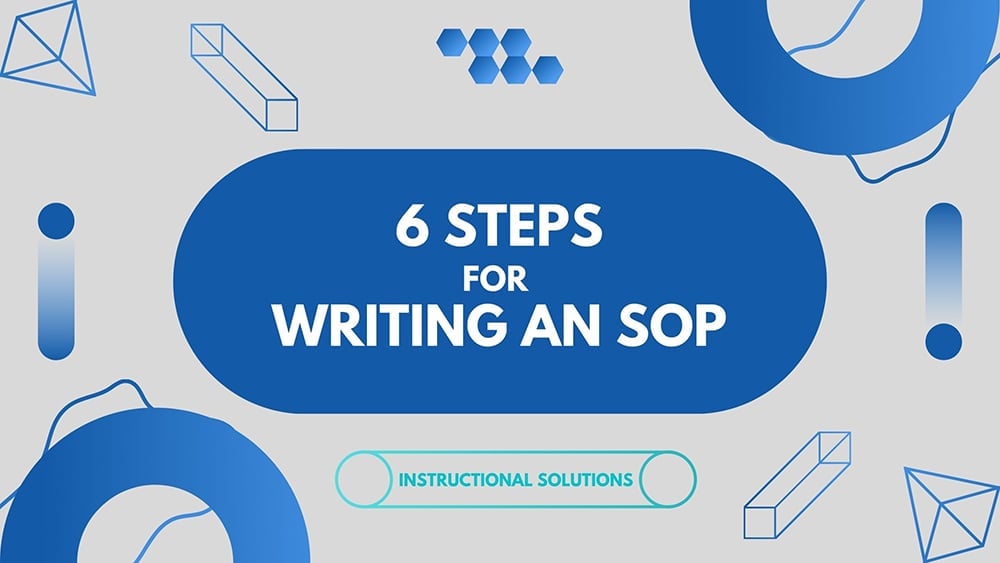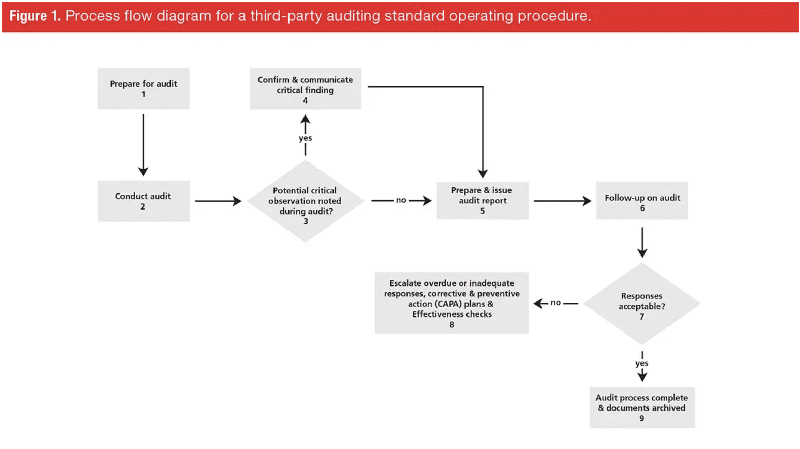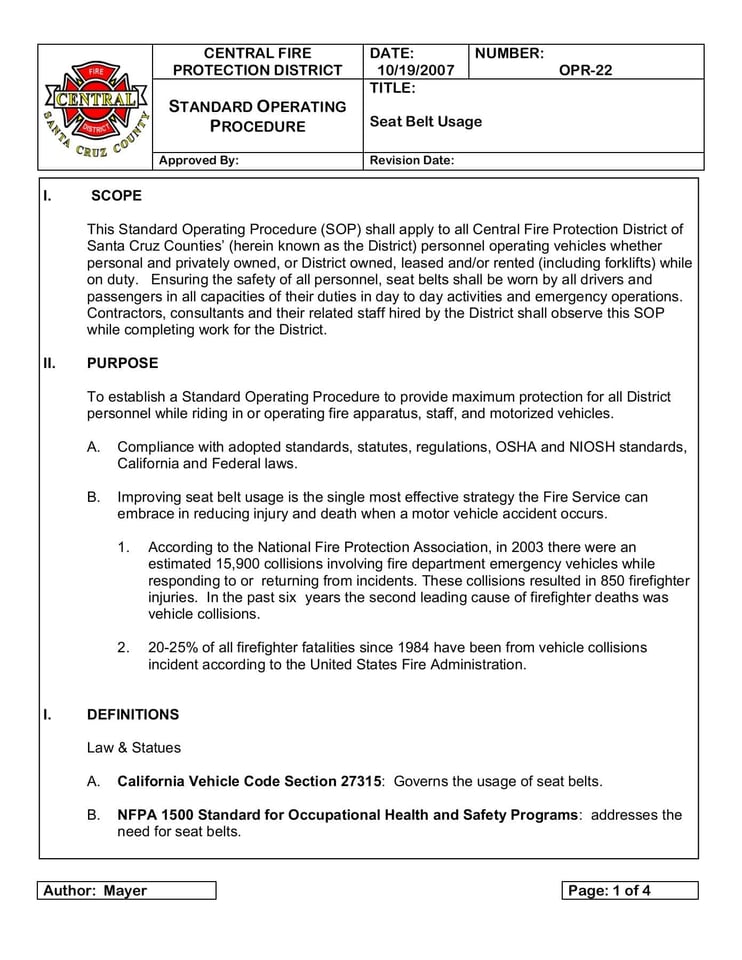6 Steps for Writing an SOP | Instructional Solutions

Writing with AI - Learn more


Step instructions or standard operating procedures are vital for consistent and safe operations -- but they are not always the easiest task to write! You also want to ensure directions are straightforward, so they're followed.
Let's first break down what an SOP is. We'll then go into six steps to make the SOP writing process as simple as possible.
Standard operating procedures (SOP) are step-by-step instructions detailing how workers should carry out their everyday tasks or a business process.
The main sectors that use SOPs are manufacturing and warehousing, but SOPs are also found in restaurants, education, and hotels.
Here are some examples and the purpose of each:
Even if your company has an SOP template, there are key steps for writing an SOP that we recommend following:
Our Technical Foundations Course is available for individuals and groups online, virtually, and onsite.
View Course & OutlineYou need to step deeply into the shoes of your intended reader for standard operating procedures.
Go back in time to when you were a newbie in your workspace. Remember what it felt like not to know how to navigate on the job. With your experience in mind, answer these questions:
Use the answer to the last question to pinpoint the document's purpose.
Also, ask for assistance from subject matter experts (SMEs) within the organization to ensure quality standards are met. These experts might be in Marketing, IT, Human Resources, etc. Management leaders should be involved in the process.
Pose the following questions to yourself and your SMEs to determine why a specific SOP is needed:
Write down the answers to these questions and let them guide your content. For example, perhaps your target reader is all employees in the company. You're writing an emergency procedure for a fire drill.
The purpose of the fire drill procedure is to help the reader understand where everyone should go in the case of a fire drill, noting specific routes and offering alternatives.
Hint: Review existing policies and procedures and incorporate information from these documents if needed to ensure consistency.
Next, generate content ideas. Maybe you already know what complex steps and detailed instructions need to be included. Write them down. Or perhaps you need to do more research. Continue to interview SMEs or team members to determine necessary tasks or basic steps.
Organize all of this info into an outline or concept map (an excellent visual way to organize complex ideas). Categorize and sequence the information. Place "like content with like content." Also, create headings that briefly summarize the contents of each section.

[Source]
For additional support, check out some well-rated tools, either free or available for a small monthly fee: ProcedureFlow, Process Street, and Method Grid.
Related: How to Improve Your Procedure Writing
Select an SOP format that will help the reader easily digest the information:

[Source]
You could also combine a visual format with a written one. Whichever format you choose, the content will be the biggest factor in your success.
Tip: Looking to master the art of writing SOPs? Enroll in our SOP writing course now.
With your content plan in place, time to write the actual content (this should be the easy part if you were thorough in your planning).
Here are our best tips for writing your first SOP draft:
The following standard operating procedure example is for the Central Fire Protection District of Santa Cruz Counties' personnel operating vehicles. It outlines the scope, purpose, definitions, etc., of using these vehicles to enforce safety laws and the safety of the drivers.

[Source]
Notice how this SOP includes the purpose of the document at the top, so the reader knows what to expect before reading. The writer incorporated clear headings and white space through the use of bulleted lists and paragraphs to create digestible content.
Hint: Don't edit the document until you've finished writing. Trying to edit and write at the same time typically makes you feel stuck and frustrated in the process.
Time for quality assurance or quality control. Allow team members to follow the procedure and ask for feedback. Identify any problems, such as missing steps, and revise procedures if needed.
You can set up a testing environment in one of two ways:
Keep an open mind. You need more input to improve your output. Writing an SOP is, without a doubt, a highly iterative process. Collaboration also provides a sense of ownership and consistent outcomes.
Once you've tested your SOP, thoroughly edit your document. Start by reviewing the substance again. Does it match your reader's needs and the purpose you identified at the beginning? Is it easy to understand? Update or revise if needed.
Next, edit for grammar. We always recommend using a grammar check, such as Grammarly. This tool helps make sure that you don't have any careless errors, especially in important documents.
Comprehension is also key with an SOP. Consider using a readability tool -- that is even better than a colleague combing through your every word.
Related: 10 Types of Technical Writing
As you can see, the entire process of writing standard operating procedures should be methodical.
Follow the above step instructions: carefully plan out your audience and SOP purpose, generate your content, write out detailed steps, and receive the support of experts and tools when you need them.
Finally, keep your procedure document up to date by reviewing and potentially revising it at least once per year (ensure that it still meets the policy requirements).
An SOP should clearly explain the steps required to complete a task or internal process, along with any tools, materials, safety guidelines, and resources (like a simple checklist) needed. Additionally, an SOP may include definitions of terms used in the document or links to reference documents that readers might need to consult to understand the SOP.
An SOP should not contain instructions that would be better suited to a manual, such as detailed descriptions of how to use specific software. Additionally, an SOP should not include subjective opinion or commentary that is not directly related to the task at hand.
A policy is a broad statement of intent, and it outlines the direction an organization intends to take in general. It may also guide actions that are prohibited or discouraged. An SOP, by contrast, is a more specific step-by-step guide document that provides detailed instructions on how to complete a particular task. An SOP includes exact steps and instructions that allow users to understand exactly what needs to be done.
Standard operating procedure document (SOPs) provide a consistent set of instructions for completing a task. Without SOPs, tasks may be completed differently each time, resulting in confusion and inconsistency. With an SOP, there is a single document that can be used to train new employees or serve as a reference when needed.
It's important to create an SOP whenever there is a task or internal process that needs to be completed on a regular basis. This could be something like a monthly financial report, or daily maintenance of equipment in the office. This way, anyone who needs to complete the task can do so quickly and accurately by following the instructions in the SOP.
